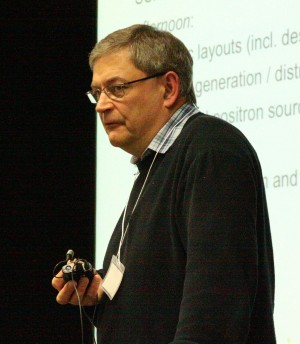Last year was an especially exciting year for particle physics with the discovery of a 126-GeV particle that appears to be the long-sought Higgs boson. This event is likely to be the most important discovery in decades: the observation of a new kind of particle that signals the mechanism for creating mass in the universe. These impressive early results already point to future directions for the LHC, and more broadly for particle physics. In fact, closer to home, this discovery is providing strong motivation for a Japanese initiative for a staged approach to the ILC, beginning with a ~250 GeV Higgs factory, with the capability of increasing the energy in the longer term.
For the ILC, last year was also a special year! We have achieved almost all of our ILC R&D goals, we finalised the ILC technical design, and we have completed and submitted for reviewing a draft version of the Technical Design Report.
The first big goal when ICFA formed the Global Design Effort (GDE) was to develop what we called a reference design for the ILC. The goal of this two-year conceptual design project was to establish the capability of an electron-positron collider that would meet the physics goals established by the ILCSC, an ICFA subcommittee, and to estimate the cost for such a new global machine. We successfully achieved those goals and published a four-volume report with a reference design, in collaboration with the ILC detector and physics collaborations.

The GDE Executive Committee signing off on the draft TDR for technical review at a special meeting at Fermilab in November
Following the completion of the RDR, we undertook to do a more detailed and optimised design and to complete the high-priority R&D goals. The objective was to develop a design and costing that could be used to approach governments. Our original idea and approach to this phase of our work was to perform a grounds-up value engineering study to establish a new baseline and design. Unfortunately, we lacked sufficient resources to perform such a study, and alternately, we tasked the GDE project managers to develop a finite set of top-down changes that promised to reduce costs, while preserving performance and not unduly increasing risk. They responded by creating a rather innocent looking paper called ‘Strawman Baseline Proposal 2009’.
This document served as the starting point for a set of workshops and studies, including detector representatives where there were possible impacts on physics. We followed a formal change control process to decide on these changes one by one. The project managers deserve substantial credit for the fact that most of their original proposal has been implemented for the Technical Design Report.

Nick Walker, GDE Project Manager, presenting the GDE TDR design overview at the PAC TDR Technical Review
After having determined the top-level baseline for the TDR, we carefully went through and made decisions on all the smaller changes that flowed down from these baseline changes. That was completed last spring, establishing our baseline for the Technical Design Report. The last step to complete our mandate has been to document the present design and results from our R&D programme in a Technical Design Report that also includes a new value costing for the ILC.
We accomplished all of those tasks in 2012, have already undergone a technical review of the TDR in December that will be followed by an International Cost Review in London in early February. We have not yet received a review report from the Technical Review, but all indications in the oral close-out were favourable.
We look forward to completing the GDE mandate over the coming months, as well as helping facilitate the evolution to the new Linear Collider Collaboration under Lyn Evans that will carry out the next steps, hopefully leading to an early ILC construction project.



Recent Comments